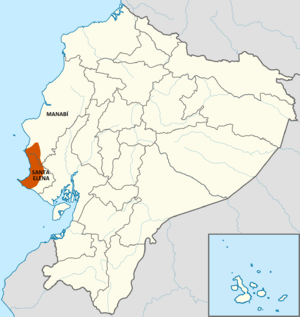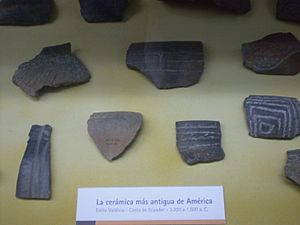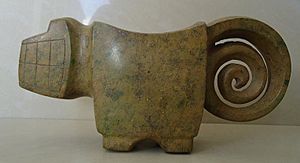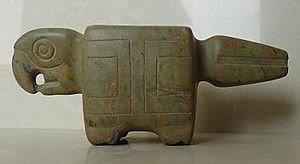Valdivia culture facts for kids

Map of Valdivia culture
|
|
| Geographical range | Santa Elena |
|---|---|
| Period | Late Archaic |
| Dates | 3500 - 1500 BCE |
| Preceded by | Las Vegas culture |
| Followed by | Machalilla culture, Cotocollao culture |
The Valdivia culture was one of the first settled groups of people in the Americas. They lived on the Santa Elena peninsula in what is now Ecuador. This culture existed from about 3500 BCE to 1500 BCE. They grew out of an older group called the Las Vegas culture.
Life in the Valdivia Culture
The Valdivia culture was first found in 1956. An Ecuadorian archeologist named Emilio Estrada discovered their remains. He studied them on the western coast of Ecuador. Later, American archeologists Clifford Evans and Betty Meggers joined him.
The Valdivia people lived in settled villages. Their houses were often built in a circle or oval shape. These homes surrounded a central open area or plaza. They were mostly settled people. They got most of their food from fishing. They also did some farming. Sometimes, they hunted deer to add to their meals.
Archeologists have found evidence of what they grew. The Valdivians farmed maize (corn), kidney beans, squash, and cassava. They also grew chili peppers and cotton plants. The cotton was used to make clothing. They would process it, spin it into thread, and then weave it.
Valdivian Pottery and Art
Valdivian pottery is some of the oldest in the Americas. The earliest pieces, from around 2700 BCE, were simple and useful. Over time, their pottery became more detailed and beautiful. They often used red and gray colors. Polished dark red pottery is a special feature of the Valdivia period. Their art, both in clay and stone, shows how they improved their skills. They went from simple designs to very complex ones.
The most famous Valdivian artworks are the "Venus" figures. These are small ceramic statues of women. Each "Venus" figure seems to be unique. This suggests they might have represented real people. Their hairstyles are all different. The figures were made by joining two rolls of clay. The bottom part formed the legs. The top part became the body and head. Their arms were usually short. They were often bent towards the chest or under the chin.
You can see many Valdivian artifacts today. There is a special display at Universidad de Especialidades Espíritu Santo. This university is in Guayaquil, Ecuador.
How Valdivia Culture Grew
For a long time, people thought Valdivia pottery was the oldest in South America. It was dated to about 3000-2700 BCE. In the 1960s, some researchers noticed something interesting. They saw similarities between Valdivia pottery and pottery from the ancient Jōmon culture in Japan. The Jōmon culture was active at the same time. Both cultures used similar ways of decorating their pottery.
This led to a theory that Japanese fishermen might have traveled to Ecuador. They could have been blown off course by a storm. Then, they might have shared their pottery skills with the Valdivia people. However, this idea was challenged by other archeologists. They pointed out that the distance was huge. It was about 15,000 kilometers (8,000 nautical miles). It would have been very hard for people to survive such a long trip in simple boats.
Later discoveries helped to solve this mystery. Archeologists found older, simpler pottery below the Valdivia sites. This pottery, called San Pedro pottery, came before the Valdivia style. This showed that Valdivian pottery likely developed on its own. It didn't need outside help. Some researchers now think pottery might have come from northern Colombia. Very old pottery was found there at the Puerto Hormiga archaeological site. Also, the corn grown by the Valdivia people probably came from closer areas. It likely came from Mesoamerica, where corn was first grown.
New studies have changed how we understand the Valdivia culture. Archeologists have explored many sites. These include coastal places like San Pablo and Real Alto. They also looked at inland areas like Loma Alta. Now, the Valdivia culture is seen as a "tropical forest culture." They focused their settlements along rivers. This new research has helped us learn much more about their way of life.
See also
 In Spanish: Cultura valdivia para niños
In Spanish: Cultura valdivia para niños




